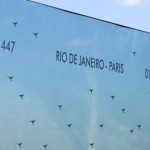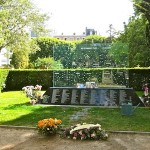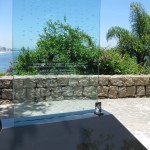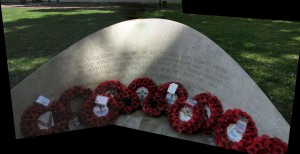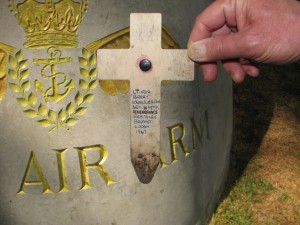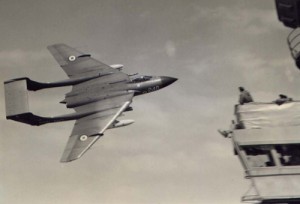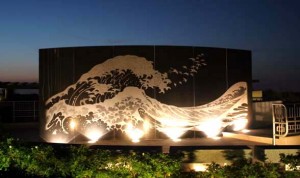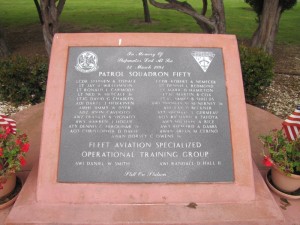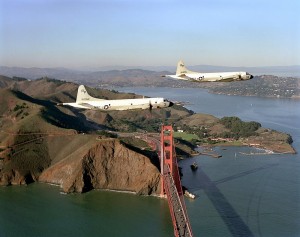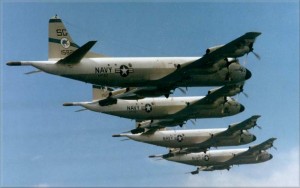Archive for the 'Air Crashes' Category
 The recent disappearance of Malaysia Airlines Flight 370 has drawn comparisons to the loss of Air France Flight 447 on June 1, 2009. Air France was on a flight from Rio de Janeiro to Paris. It was lost approximately 600 miles northeast of Natal, Brazil in the Atlantic Ocean, at a cost of 228 lives. While the precise location of the crash was known almost immediately, with pieces of wreckage and bodies recovered within days, it would take almost two years for the majority of the aircraft to be located on the bottom of the Atlantic and for the flight recorders to be recovered. Analysis of the flight recorder data confirmed early predictions about the cause of the accident. Icing on the aircraft pitot tube sensors caused speed sensors to report incorrect data, at which time the autopilot disengaged. The flight crew became confused by the loss of instrumentation, never fully realizing the exact nature of their situation. The actions of the crew resulted in a stall and a subsequent loss of controlled flight, the aircraft plunging 33,000 feet into the Atlantic Ocean. Recovery efforts over two long years resulted in finding the remains of the majority of the passengers and crew. No remains for 50 people were recovered, however. Those 50 remain forever lost at sea.
The recent disappearance of Malaysia Airlines Flight 370 has drawn comparisons to the loss of Air France Flight 447 on June 1, 2009. Air France was on a flight from Rio de Janeiro to Paris. It was lost approximately 600 miles northeast of Natal, Brazil in the Atlantic Ocean, at a cost of 228 lives. While the precise location of the crash was known almost immediately, with pieces of wreckage and bodies recovered within days, it would take almost two years for the majority of the aircraft to be located on the bottom of the Atlantic and for the flight recorders to be recovered. Analysis of the flight recorder data confirmed early predictions about the cause of the accident. Icing on the aircraft pitot tube sensors caused speed sensors to report incorrect data, at which time the autopilot disengaged. The flight crew became confused by the loss of instrumentation, never fully realizing the exact nature of their situation. The actions of the crew resulted in a stall and a subsequent loss of controlled flight, the aircraft plunging 33,000 feet into the Atlantic Ocean. Recovery efforts over two long years resulted in finding the remains of the majority of the passengers and crew. No remains for 50 people were recovered, however. Those 50 remain forever lost at sea.
Two similar monuments on opposite sides of the Atlantic memorialize the lives lost. One monument is located in the Pere-Lachaise cemetery in Paris. The largest cemetery in Paris at 119 acres, this elegant cemetery holds the last earthly remains of thousands of souls, many the most famous in French and world history. Outside of Rio de Janeiro, on an ocean site facing the direct route to Paris, stands a similar monument. Both monuments feature an etched glass pane with 228 birds flying on the panes. The panes rest on black granite bases which list the names of all 228 lives lost. The etched glass contains the specifics of the accident and the home countries of the dead.
The location of the two monuments is both obvious and fortuitous. While they include the departure point and intended destination of Air France 447, these sites assure that thousands every year will visit the monuments. The symbolism of the birds on the glass panes is quite beautiful and meaningful – while the earthly lives of the crew and passengers of Air France 447 may have ended in the Atlantic Ocean, their souls have taken flight to their ultimate destinations.
 In the Victoria Embankment Gardens along the river Thames in London is a memorial to the Fleet Air Arm of the Royal Navy. The memorial is a striking bronze figure of Daedalus, the ingenious craftsman of Greek legend who created wings to escape King Minos of Crete, only to lose his son Icarus when he flew too close to the sun and his wings melted. Icarus plunged into the sea…
In the Victoria Embankment Gardens along the river Thames in London is a memorial to the Fleet Air Arm of the Royal Navy. The memorial is a striking bronze figure of Daedalus, the ingenious craftsman of Greek legend who created wings to escape King Minos of Crete, only to lose his son Icarus when he flew too close to the sun and his wings melted. Icarus plunged into the sea…
The memorial was designed by Royal Academy artist and sculptor James Butler as a tribute to the more than 6,000 individuals who have given their lives in Royal Navy Air Service since World War I – 1,925 of whom have no graves except the oceans of the world.
Butler’s own words best describe the power of the statue: “I wanted Daedalus to appear mighty, strong and capable, a man and yet half machine, with wings which are an integral part of him and yet still clearly man-made and fastened crudely to his arms. He must have an air of tragedy in his countenance, after all he is mourning the death of his colleagues. With his arms outspread in this position and his head slightly bowed, there are suggestions of crucifixion which signal the sacrifice of the brave men and women in their Naval Service over the years.”
When I saw the statue a few weeks ago on a visit to London with my wife, I noticed some very small, individual tributes left at the base. One was a small wooden cross in memory of “Lt. Commander ‘Barry’ Knowles, RN”. I did some research on Commander Knowles on my return to the United States. David Barry Knowles and his crew mate Ian E. Shaw were lost in the crash of a Sea Vixen aircraft in the Irish Sea on December 4, 1967. The Sea Vixen was a beautiful but exceptionally unforgiving aircraft operated by the Royal Navy off their aircraft carriers for over a decade. Almost 60 Royal Navy aviators lost their lives flying the Sea Vixen.
The Fleet Air Arm Memorial is a truly moving and powerful symbol of the sacrifices of David Barry Knowles, Ian Shaw, and the thousands of others who gave so very much in the service of their country…
 The recent news that some of the wreckage of Air France 447 (lost on a flight from Rio to Paris) was located in the Atlantic Ocean has turned my thoughts to the 1996 crash of TWA 800 – a Boeing 747 lost with 230 souls on board on July 17, 1996. The aircraft was on a scheduled flight from New York Kennedy airport to Paris when it exploded in mid-air a few minutes after departure.
The recent news that some of the wreckage of Air France 447 (lost on a flight from Rio to Paris) was located in the Atlantic Ocean has turned my thoughts to the 1996 crash of TWA 800 – a Boeing 747 lost with 230 souls on board on July 17, 1996. The aircraft was on a scheduled flight from New York Kennedy airport to Paris when it exploded in mid-air a few minutes after departure.
This is perhaps the most thoroughly investigated commercial air crash in history. 95% of the aircraft was eventually recovered from the Atlantic waters, 14 miles east of Long Island. While numerous theories of what caused the accident abound on the Internet – terrorism, a U.S. Navy surface-to air-missile strike, explosives strapped to a dog, and others – the official National Transportation Safety Board report found that an explosion in the center wing fuel tank caused the destruction of the aircraft. The ignition source for the explosion was never determined, although spurious static electricity or faulty wiring were named as likely culprits. The NTSB and the FAA have repeatedly attempted to implement safety measures to reduce the potential for this type of accident – generally nitrogen or other inert gases pumped into aircraft fuel tanks as they empty. To my knowledge no aircraft have been retro-fitted with these devices, nor are these devices required on new aircraft. The reason cited for inaction is generally excessive cost.
The TWA 800 International Memorial is located at Smith Point Country Park, which fronts the Atlantic Ocean on the east end of Fire Island – central Long Island, New York. The memorial location faces the actual accident location in the Atlantic Ocean.
The memorial itself extends over two full acres. Included are paths which lead through over 10,000 donated plants and vegetation surrounding a main central plaza. A large curved granite wall is the focal point of the plaza. On one side of the granite wall are engraved the names of the 230 victims of the loss of TWA 800. The other side of the granite wall is an illustration of 230 seagulls released into the sky, particularly striking when viewed at night. Flags of 14 nations, representing the countries of passengers and crew, are set near the central plaza. In 1986 an abstract lighthouse was added. Below the lighthouse is a tomb holding the personal effects of many of those lost on that July night.
Partial remains of almost all of the 230 victims were recovered and eventually identified through DNA testing. These remains were returned to the victims’ families. This process took almost one year. No remains of two victims (one American and one French) were ever discovered. They lie at the bottom of the Atlantic off the east coast of Long Island – forever lost at sea…
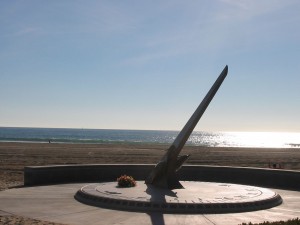 On January 31, 2000 Alaska Airlines Flight 261 plunged into the Pacific Ocean near the Channel Islands off the beautiful beaches of Southern California. The aircraft was a McDonnell Douglas MD-83 on a scheduled flight from Puerto Vallarta, Mexico to Seattle, Washington, with an intermediate stop at San Francisco. All eighty-eight passengers and crew aboard the aircraft were killed, many lost at sea.
On January 31, 2000 Alaska Airlines Flight 261 plunged into the Pacific Ocean near the Channel Islands off the beautiful beaches of Southern California. The aircraft was a McDonnell Douglas MD-83 on a scheduled flight from Puerto Vallarta, Mexico to Seattle, Washington, with an intermediate stop at San Francisco. All eighty-eight passengers and crew aboard the aircraft were killed, many lost at sea.
This accident is one of the most written about in recent memory, mainly because it was determined to be caused by a mechanical failure that could have been prevented. A simple jackscrew mechanism that controlled stabilator trim on the aircraft failed – resulting in a total loss of pitch control. The aircraft plunged nose first into the water, despite all efforts to regain control of the aircraft by the flight crew. This tragic loss was due to a failure to perform routine maintenance by Alaska Airlines and a failure to conduct adequate oversight of maintenance by the Federal Aviation Administration.
The Sundial Memorial at Port Hueneme Beach Park is a beautiful combination of remembrance of the dead and a vision of hope for the living. Designed by Santa Barbara artist James “Bud” Bottom, the memorial consists of a 20 foot diameter base and an 11-foot tall bronze arm. The names of the victims are found on bronze plaques circling the base. Every year, on January 31st, at the exact time of the crash, the shadow caused by the bronze arm darkens a special plaque on the sundial’s face.
Port Hueneme was the base of operations for recovery efforts after the crash. On the one year anniversary on the crash, a boat from Port Hueneme ferried family members to the crash site near Anacapa Island. The boat was surrounded by a pod of approximately 1,000 dolphins at the crash site – an enduring memory for all those on that ferry that day.
Dolphins, according to legend, help transport the souls of people lost at sea. Attached to the bronze arm of the sundial are dolphins, free of the water and soaring high. It’s a most fitting image on a memorable memorial…
In the language of the United States Navy VP-50 was “Fixed Wing Patrol Squadron 50” – also known as the Blue Dragons. From 1946 until June 30, 1992 they were an active squadron of the United States Navy. I once flew for the U.S. Navy. The death of any aviator or any sailor has an impact on all of us who earned Navy Wings of Gold – or any of the other hard-earned insignias of naval service (surface warfare, submarines, SEALS, and the other specialties).
On March 21, 1991 two P-3C Orions of VP-50 collided about 60 miles southwest of San Diego, CA in bad weather. One aircraft was relieving the other on a normal anti-submarine patrol watch. The aircraft were stationed at Naval Air Station Moffett Field, south of San Francisco, CA. I distinctly remember reading the first newspaper reports the day after the accident – 27 U.S. Navy personnel missing at sea. That is a horrific toll for any Navy squadron, whose total personnel would only be a few hundred officers and enlisted men – especially when it happened in a single instant, in peacetime. I could only imagine the shock and sorrow within the VP-50 family and NAS Moffett Field community that day.
The cause of the accident was never determined beyond it being a mid-air collision. Pilot error was probably a contributing cause – and weather, crew fatigue, and perhaps a mechanical problem additional factors. The human cost, however, was almost instantly quantified – 27 young souls lost at sea – lost forever to their wives, children, parents, friends, and shipmates. Lost, but not forgotten.
Moffett Field Naval Air Station has been closed, but Moffett Field as a civilian airport remains. Located on its grounds is a plaque listing the names of all 27 men who perished in the Pacific Ocean that night. There is another monument to these same men in Arlington National Cemetery.
I have included three photographs in this post. One is of the monument at Moffett Field, listing the names of those who perished that night. Another is of four VP-50 aircraft in flight. And one is of two P-3C Orion aircraft flying over the Golden Gate Bridge. These are not VP-50 aircraft, but I know every man who ever flew with VP-50 out of Moffett Field witnessed this view. They loved flying for moments like this.
Please visit the VP-50 web page devoted to the men who died that night at: http://www.vpnavy.com/vp50mem_04dec98.html
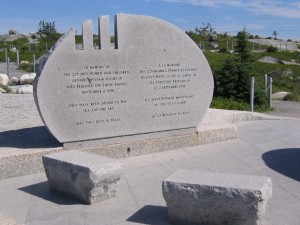
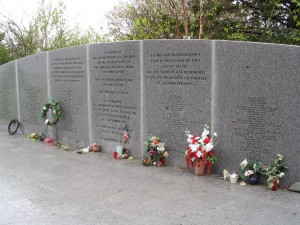 On opposite shorelines of St. Margarets Bay, Nova Scotia are two memorials to the victims of the September 1998 crash of Swissair Flight 111.
On opposite shorelines of St. Margarets Bay, Nova Scotia are two memorials to the victims of the September 1998 crash of Swissair Flight 111.
Swissair Flight 111 was a McDonnell Douglas MD-11 on a scheduled flight between New York’s JFK airport and Geneva, Switzerland. Faulty wiring in the first class entertainment system led to a fire. The fire found a ready fuel source in the flammable material used as insulation within the fuselage. The fire grew rapidly, resulting in instrument failure and eventual loss of control of the aircraft.
The violence of the crash is almost impossible to comprehend. The aircraft hit the water with a force of impact of at least 350 g – instantly disintegrating into 2 million pieces. The accident investigation by the Transportation Board of Canada took over four years. The human toll was 229 souls from twenty nations – lost in an instant.
The Royal Canadian Mounted Police medical examiners made every effort to identify the victims. Fingerprints, dental x-rays, and the largest DNA identification project in Canadian history eventually identified body parts from everyone on board. But there is no doubt that body parts from virtually every victim were lost at sea that fateful night, a few miles off this most beautiful part of the Nova Scotia coast.
The Canadian Government established two memorials to the dead of Swissair Flight 111 on opposite sides of St. Margarets Bay. About one-half mile from the iconic Peggy’s Cove lighthouse is a memorial made of Nova Scotia granite paying tribute to all the dead collectively. The three notches in the top corner of the monument form the number 111 – and when peered through the back side of the memorial point exactly to the crash site about seven miles offshore.
On the other side of St. Margarets Bay, near Bayswater Beach, is a larger monument listing the names of all 229 victims. Unidentified remains of the victims are also interred at this spot.
Information on the accident abounds on the Internet. Several excellent documentaries can be found on YouTube. These include actual air traffic and cockpit recordings, computer generated recreations of the events leading to the accident, and interviews with accident investigators. The memorials themselves, including enormous background material and beautiful photographs, are highlighted at the following links:
http://ns1763.ca/hfxrm/swisswhale.html (The Whalesback – Peggy’s Cove Memorial)
http://ns1763.ca/lunenco/swissbaysw.html (The Bayswater Memorial)
Aircraft accidents are perhaps the most difficult of all lost at sea scenarios for family and friends. The accidents often happen thousands of miles from where victims’ loved ones reside, whatever recovery that is possible might take weeks or months to accomplish, the accident investigation itself might take years, and the passengers themselves are generally strangers to each other – meaning that those who grieve are also strangers to each other, thrown together under the most stressful and tragic of circumstances. I suspect that beautiful memorials such as these in Nova Scotia serve to bring mourners together for a common purpose, under less stressful conditions, where time alone has performed some healing – and that strangers are strangers no more…
